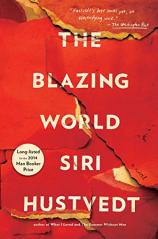The Blazing World
Review
The Blazing World
Siri Hustvedt's new novel, THE BLAZING WORLD, takes its name from the most famous work by the 17th-century writer Margaret Cavendish. Cavendish once wrote, "And if she be slighted now and buried in silence, she may perhaps rise more gloriously hereafter; for her ground being sense and reason, she may meet with an age where she will be more regarded than she is in this." These lines are quoted in one of the many notebooks kept by Hustvedt's protagonist, Harriet (known as Harry) Burden. Burden is an artist who, like Cavendish herself, may feel that the world is not yet ready for what she has to give it: "I will leave my bodies behind me, too," writes Burden in her notebook. "I am making them for hereafter, not for the bruising present with its cold, dismissive eyes."
"As intellectually engaging as THE BLAZING WORLD is, it is also a fascinating example of playful and intricate narrative structure."
Harry certainly knows a bit about dismissiveness. Following only modest success of her artwork and appreciation of her art criticism early in her career, she sets out on a new project, one that she suspects (rightly so) will offer her work --- if not herself --- a new level of fame. Over the course of several years, she selects three different male artists, at various levels of their own careers, to serve as "masks" for her. She will design massive and ambitious art installations to which they will attach their name, taking all the credit and receiving all the (inevitable) accolades. At first, the experiment goes exactly how Harry had predicted: the young, unknown male artist is accepted and applauded in a way she never would have been. But when she taps a more established artist, a filmmaker named Rune, to be her final partner, their complicated relationship and Rune's own ideas about art and fame threaten to derail the entire undertaking.
Harry's experiment offers countless opportunities for considering questions of gender and fame, particularly in the art world, but also for considering issues of visibility and invisibility, of perception and understanding, of self and identity. Harriet writes in one of her notebooks, "I am myself a myth about myself. Who I am has nothing to do with it." Along the way, Hustvedt invokes everyone from Kierkegaard to Freud to Cavendish herself in this psychologically and philosophically rich novel of art and ideas.
As intellectually engaging as THE BLAZING WORLD is, it is also a fascinating example of playful and intricate narrative structure. The novel is framed as an academic study of Burden's life and work, containing excerpts from some of Harry's dozens of idiosyncratically organized, often fragmentary diaries, as well as written statements from and interviews with those who loved, admired and collaborated with her. Just like the viewers of Harry's art, readers of this book are challenged to piece together their own conception of who Harry was and what she accomplished. "To be really seen, Harry had to be invisible," writes one of the three male artists whose persona Harry adopted. Discerning and defining the invisible woman at the heart of Hustvedt's narrative is a joint project between writer and reader, and an exhilarating process of which to be a part.
Reviewed by Norah Piehl on March 28, 2014
The Blazing World
- Publication Date: November 4, 2014
- Genres: Fiction
- Paperback: 384 pages
- Publisher: Simon & Schuster
- ISBN-10: 1476747245
- ISBN-13: 9781476747248





